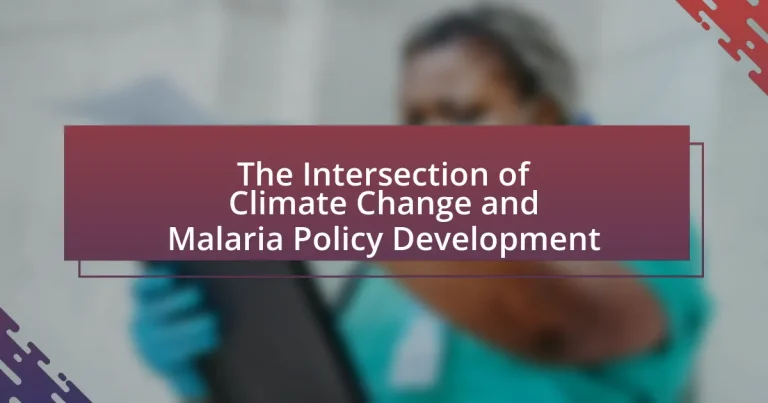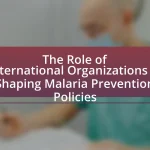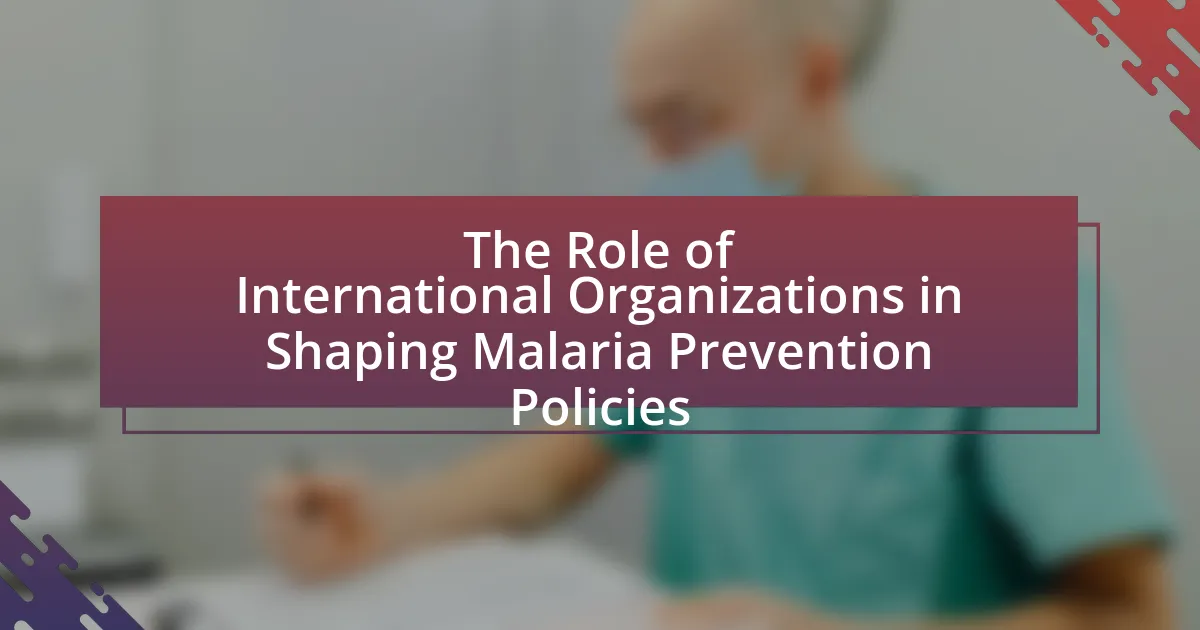The article examines the critical intersection of climate change and malaria policy development, highlighting how climate change affects malaria transmission dynamics through rising temperatures, altered precipitation patterns, and increased extreme weather events. It discusses the environmental factors contributing to the spread of malaria, the importance of integrating climate adaptation strategies into malaria policies, and the key objectives of such policies, including reducing transmission and improving healthcare access. Additionally, the article addresses the challenges of implementing effective policies in the context of climate change, the role of socio-economic factors, and the necessity for collaboration among stakeholders to enhance malaria control efforts. It emphasizes the need for innovative technologies and data analytics to inform future policy responses and ensure sustainability in malaria interventions.
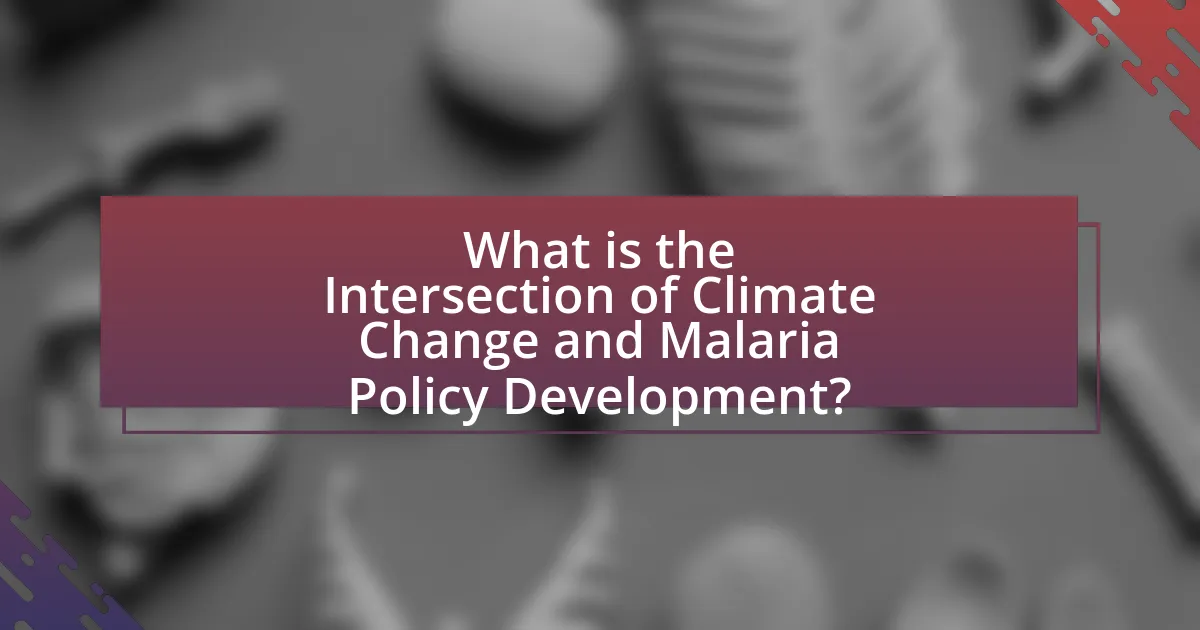
What is the Intersection of Climate Change and Malaria Policy Development?
The intersection of climate change and malaria policy development involves the recognition that climate change significantly influences malaria transmission dynamics. Rising temperatures, altered precipitation patterns, and increased frequency of extreme weather events can expand the habitats of malaria vectors, such as Anopheles mosquitoes, thereby increasing the risk of malaria outbreaks in previously unaffected regions. For instance, research published in the journal “Nature Climate Change” indicates that a 1°C increase in temperature could lead to a 10-20% increase in malaria transmission in some areas. Consequently, effective malaria policy development must integrate climate adaptation strategies to mitigate these risks, ensuring that public health responses are resilient to the impacts of climate change.
How does climate change influence malaria transmission?
Climate change influences malaria transmission by altering environmental conditions that affect the lifecycle of malaria vectors, primarily mosquitoes. Rising temperatures expand the geographical range of these vectors, allowing them to thrive in previously unsuitable areas. For instance, studies indicate that a 1°C increase in temperature can enhance the development rate of the malaria parasite within mosquitoes, leading to increased transmission rates. Additionally, changes in precipitation patterns can create more breeding sites for mosquitoes, further facilitating the spread of malaria. Research published in the journal “Nature Climate Change” highlights that regions experiencing increased rainfall and warmer temperatures are at a higher risk for malaria outbreaks, demonstrating the direct correlation between climate change and malaria transmission dynamics.
What environmental factors contribute to malaria spread due to climate change?
Rising temperatures, increased rainfall, and altered humidity levels are environmental factors that contribute to the spread of malaria due to climate change. Warmer temperatures enhance the breeding and survival rates of Anopheles mosquitoes, the primary vectors of malaria, while increased rainfall creates more stagnant water sources for mosquito breeding. Additionally, changes in humidity can affect mosquito lifespan and transmission dynamics. Research indicates that a 1°C increase in temperature can lead to a significant rise in malaria transmission potential, particularly in regions previously unsuitable for the disease.
How do temperature and rainfall patterns affect malaria vectors?
Temperature and rainfall patterns significantly influence malaria vectors, primarily by affecting their breeding, survival, and feeding behaviors. Warmer temperatures can accelerate the development of malaria parasites within the vectors, such as Anopheles mosquitoes, thereby increasing transmission rates. For instance, a study published in the journal “Nature Climate Change” found that a 1°C increase in temperature can reduce the extrinsic incubation period of the malaria parasite, enhancing the likelihood of transmission. Additionally, rainfall patterns determine the availability of breeding sites; increased rainfall creates more stagnant water, which serves as ideal habitats for mosquito larvae. Research from the World Health Organization indicates that regions experiencing higher rainfall are often associated with increased malaria incidence due to the proliferation of vector populations. Thus, both temperature and rainfall are critical factors in shaping the dynamics of malaria transmission through their direct effects on vector biology.
Why is malaria policy development crucial in the context of climate change?
Malaria policy development is crucial in the context of climate change because climate change significantly alters the transmission dynamics of malaria. Rising temperatures and changing precipitation patterns can expand the habitats of malaria-carrying mosquitoes, increasing the risk of outbreaks in previously unaffected regions. For instance, research indicates that a 1°C increase in temperature can enhance the development and survival of the malaria parasite within mosquitoes, leading to higher transmission rates. Therefore, effective malaria policies must adapt to these climatic changes to mitigate the potential for increased malaria incidence and protect public health.
What are the key objectives of malaria policy development?
The key objectives of malaria policy development include reducing malaria transmission, improving access to effective prevention and treatment, and enhancing surveillance and response systems. These objectives aim to lower the incidence and mortality rates associated with malaria, which affected an estimated 241 million cases globally in 2020, according to the World Health Organization. Additionally, policies focus on integrating malaria control efforts with broader health initiatives and addressing the impacts of climate change on malaria transmission patterns, as rising temperatures and changing rainfall can influence mosquito breeding and disease spread.
How can effective policies mitigate the impact of climate change on malaria?
Effective policies can mitigate the impact of climate change on malaria by implementing targeted vector control measures, enhancing surveillance systems, and promoting community health education. These policies can reduce mosquito populations and limit the spread of malaria, particularly in regions where climate change is altering habitats and increasing transmission rates. For instance, the World Health Organization recommends integrated vector management strategies that adapt to changing environmental conditions, which can significantly lower malaria incidence. Additionally, investing in climate-resilient health infrastructure ensures that healthcare systems can respond effectively to malaria outbreaks exacerbated by climate variability.
What challenges arise in integrating climate change into malaria policy?
Integrating climate change into malaria policy presents several challenges, primarily due to the complexity of climate impacts on malaria transmission dynamics. One significant challenge is the variability in climate data, which complicates the prediction of malaria outbreaks linked to changing weather patterns. For instance, studies indicate that temperature and rainfall fluctuations can alter mosquito breeding sites and survival rates, making it difficult for policymakers to develop effective, evidence-based strategies. Additionally, the lack of interdisciplinary collaboration among climate scientists, epidemiologists, and public health officials hinders the creation of comprehensive policies that address both climate change and malaria control. Furthermore, limited funding and resources for research on the intersection of these fields restrict the ability to implement adaptive measures in malaria-endemic regions.
What are the barriers to effective policy implementation?
Barriers to effective policy implementation include inadequate funding, lack of stakeholder engagement, insufficient data, and bureaucratic inefficiencies. In the context of climate change and malaria policy development, inadequate funding often limits the resources available for research and intervention programs, which are crucial for addressing the complexities of malaria in changing climates. Lack of stakeholder engagement can lead to policies that do not reflect the needs of affected communities, resulting in poor compliance and effectiveness. Insufficient data hampers the ability to make informed decisions, as policymakers may not fully understand the relationship between climate change and malaria transmission dynamics. Bureaucratic inefficiencies can slow down the implementation process, causing delays that undermine the urgency required to address health threats posed by climate change. These barriers collectively hinder the successful execution of policies aimed at mitigating the impacts of climate change on malaria.
How do socio-economic factors influence malaria policy responses?
Socio-economic factors significantly influence malaria policy responses by determining resource allocation, access to healthcare, and community engagement. For instance, countries with higher income levels can invest more in malaria prevention and treatment programs, leading to better health outcomes. According to the World Health Organization, nations with robust health systems and economic stability are more likely to implement effective malaria control strategies, such as widespread distribution of insecticide-treated nets and access to antimalarial medications. Conversely, low-income regions often face challenges like inadequate healthcare infrastructure and limited funding, which hinder the effectiveness of malaria policies. This disparity is evident in sub-Saharan Africa, where socio-economic conditions directly correlate with malaria prevalence and response efficacy.
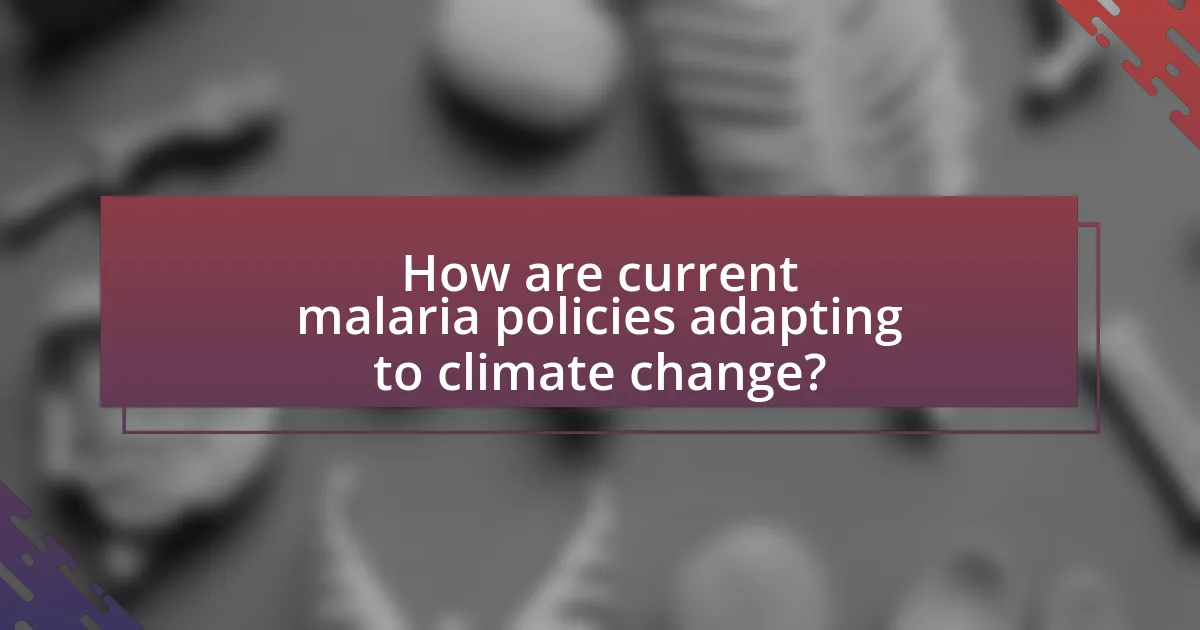
How are current malaria policies adapting to climate change?
Current malaria policies are adapting to climate change by integrating climate data into malaria risk assessments and response strategies. For instance, countries are utilizing climate modeling to predict malaria transmission patterns, allowing for targeted interventions in high-risk areas. The World Health Organization emphasizes the need for adaptive strategies, such as adjusting vector control measures and enhancing surveillance systems to account for changing environmental conditions. Additionally, research indicates that incorporating climate change projections into national malaria control programs can improve resource allocation and effectiveness, as seen in countries like Kenya and Zambia, where climate-informed policies have led to more efficient use of insecticide-treated nets and indoor residual spraying.
What strategies are being employed to address climate-related malaria risks?
Strategies employed to address climate-related malaria risks include integrated vector management, climate-resilient health systems, and community engagement initiatives. Integrated vector management focuses on using a combination of methods, such as insecticide-treated nets and environmental management, to control mosquito populations effectively. Climate-resilient health systems aim to adapt healthcare infrastructure and services to withstand climate impacts, ensuring timely malaria diagnosis and treatment. Community engagement initiatives involve educating local populations about malaria prevention and the effects of climate change, fostering local ownership of health strategies. These approaches are supported by evidence indicating that targeted interventions can significantly reduce malaria transmission in changing climates.
How are surveillance systems evolving to track malaria in changing climates?
Surveillance systems are evolving to track malaria in changing climates by integrating advanced technologies such as remote sensing, geographic information systems (GIS), and machine learning algorithms. These technologies enhance the ability to monitor environmental factors that influence malaria transmission, such as temperature, rainfall, and humidity, which are increasingly variable due to climate change. For instance, studies have shown that satellite imagery can provide real-time data on environmental conditions, allowing for more accurate predictions of malaria outbreaks. Additionally, machine learning models can analyze historical data to identify patterns and risk factors associated with malaria transmission, improving response strategies. This evolution is crucial as climate change alters the geographical distribution of malaria vectors, necessitating adaptive surveillance approaches to effectively manage and mitigate malaria risks.
What role do community engagement and education play in policy adaptation?
Community engagement and education are crucial in policy adaptation as they foster local ownership and understanding of policies, leading to more effective implementation. Engaging communities allows policymakers to gather valuable insights and local knowledge, which can inform more relevant and context-specific adaptations. For instance, studies have shown that when communities are involved in the decision-making process regarding malaria control measures, such as the use of insecticide-treated nets, compliance and usage rates increase significantly. This is evidenced by a 2018 study published in the journal “Global Health Action,” which found that community-led initiatives in malaria prevention resulted in a 30% increase in net usage in targeted areas. Education empowers communities to understand the implications of climate change on malaria transmission, enabling them to adapt behaviors and practices that mitigate risks. Thus, community engagement and education not only enhance the relevance of policies but also improve their effectiveness in addressing the challenges posed by climate change on malaria.
Why is collaboration important in malaria policy development?
Collaboration is crucial in malaria policy development because it fosters a comprehensive approach that integrates diverse expertise and resources. Effective malaria control requires input from various stakeholders, including governments, NGOs, researchers, and local communities, to address the multifaceted challenges posed by the disease. For instance, the World Health Organization emphasizes that collaborative efforts enhance data sharing, improve resource allocation, and facilitate the implementation of evidence-based strategies, ultimately leading to more effective interventions. This collaborative framework is essential, especially in the context of climate change, which can alter malaria transmission patterns and necessitate adaptive policy responses.
How do partnerships between governments and NGOs enhance policy effectiveness?
Partnerships between governments and NGOs enhance policy effectiveness by leveraging diverse expertise and resources to address complex issues like climate change and malaria. Governments provide regulatory frameworks and funding, while NGOs contribute grassroots knowledge and community engagement strategies. For instance, the collaboration between the World Health Organization and local NGOs has led to successful malaria control programs that adapt to climate variations, demonstrating improved health outcomes. This synergy allows for more comprehensive policy development that is responsive to local needs and scientific advancements, ultimately leading to more effective interventions.
What examples exist of successful collaborative malaria initiatives?
Successful collaborative malaria initiatives include the Roll Back Malaria Partnership, which unites various stakeholders to reduce malaria morbidity and mortality through coordinated efforts. Another example is the Global Fund to Fight AIDS, Tuberculosis and Malaria, which supports countries in implementing effective malaria control programs by providing financial resources and technical assistance. Additionally, the Malaria Elimination Initiative, led by the University of California, San Francisco, collaborates with governments and organizations to develop strategies for malaria elimination in specific regions. These initiatives demonstrate effective partnerships that leverage resources and expertise to combat malaria on a global scale.
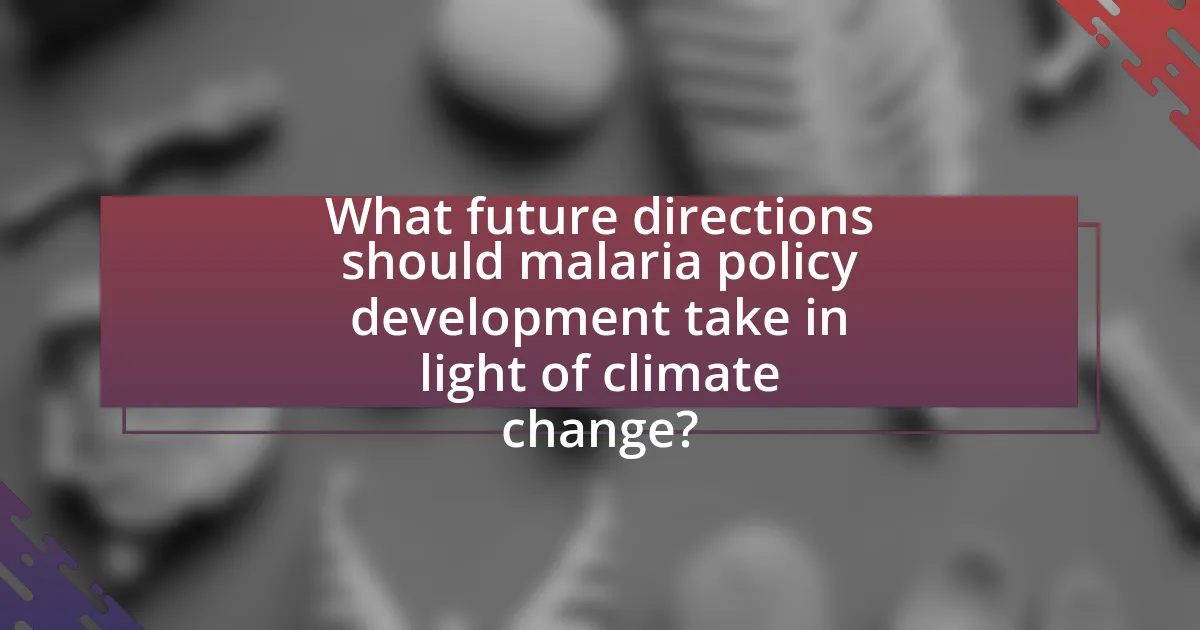
What future directions should malaria policy development take in light of climate change?
Malaria policy development should prioritize adaptive strategies that address the impacts of climate change on malaria transmission dynamics. As climate change alters temperature and precipitation patterns, these changes can expand the habitats of malaria vectors, increasing transmission risk in previously unaffected areas. For instance, research indicates that a 1°C rise in temperature can enhance the development and survival of Anopheles mosquitoes, the primary malaria vectors, leading to increased malaria cases in regions like East Africa. Therefore, policies must incorporate climate data into malaria surveillance systems, enhance vector control measures, and promote community awareness programs that educate populations about changing risks. Additionally, integrating climate resilience into health infrastructure will be crucial to ensure that healthcare systems can respond effectively to the evolving malaria landscape.
How can innovative technologies improve malaria policy responses?
Innovative technologies can enhance malaria policy responses by enabling real-time data collection and analysis, which improves decision-making and resource allocation. For instance, geographic information systems (GIS) and remote sensing technologies allow for precise mapping of malaria transmission patterns, helping policymakers identify high-risk areas and allocate interventions more effectively. A study published in the journal “Nature” highlighted that the integration of mobile health applications has increased community engagement in malaria prevention efforts, leading to a 30% increase in treatment adherence in affected regions. Additionally, machine learning algorithms can predict malaria outbreaks based on climate data, allowing for proactive measures to be implemented before cases surge. These advancements demonstrate that leveraging innovative technologies can significantly improve the effectiveness and efficiency of malaria policy responses.
What role does data analytics play in shaping future malaria policies?
Data analytics plays a crucial role in shaping future malaria policies by providing evidence-based insights that inform decision-making and resource allocation. By analyzing data on malaria incidence, transmission patterns, and environmental factors, policymakers can identify high-risk areas and target interventions more effectively. For instance, a study published in the journal “Nature” highlighted how predictive modeling using climate data can forecast malaria outbreaks, enabling timely responses and strategic planning. This data-driven approach enhances the efficiency of malaria control programs and ensures that policies are responsive to changing epidemiological trends influenced by climate change.
How can climate modeling inform malaria risk assessments?
Climate modeling can inform malaria risk assessments by predicting changes in environmental conditions that affect mosquito populations and malaria transmission dynamics. For instance, models can simulate temperature, precipitation, and humidity patterns, which are critical for understanding the habitat suitability for malaria vectors like Anopheles mosquitoes. Research indicates that temperature increases can enhance mosquito breeding rates and shorten the malaria parasite’s incubation period, leading to higher transmission potential. A study published in “Nature Climate Change” by Ryan et al. (2019) highlights that climate projections indicate a potential expansion of malaria risk areas in East Africa due to changing rainfall patterns and temperatures. Thus, integrating climate modeling into malaria risk assessments enables public health officials to anticipate outbreaks and allocate resources effectively.
What best practices can be adopted for effective malaria policy development?
Effective malaria policy development can be achieved by adopting a multi-sectoral approach that integrates health, environmental, and socio-economic factors. This approach ensures that policies are comprehensive and address the complexities of malaria transmission, particularly in the context of climate change. For instance, incorporating climate data into malaria risk assessments allows for targeted interventions in high-risk areas, as evidenced by studies showing that climate variability significantly influences malaria outbreaks. Additionally, engaging local communities in policy formulation fosters ownership and enhances the effectiveness of interventions, as community-driven initiatives have been shown to improve health outcomes. Furthermore, continuous monitoring and evaluation of malaria policies are essential to adapt strategies based on emerging evidence and changing environmental conditions, ensuring that responses remain relevant and effective.
How can policymakers ensure sustainability in malaria interventions?
Policymakers can ensure sustainability in malaria interventions by integrating climate change considerations into their strategies. This approach is essential because climate change significantly influences malaria transmission patterns, with warmer temperatures and altered rainfall affecting mosquito populations and disease spread. For instance, the World Health Organization reports that climate variability can lead to increased malaria cases in regions previously considered low-risk. By adopting adaptive management practices, investing in resilient health infrastructure, and promoting community engagement, policymakers can create long-term solutions that address both malaria control and the impacts of climate change.
What lessons can be learned from past malaria policy successes and failures?
Past malaria policy successes and failures highlight the importance of adaptive strategies and community engagement. Successful policies, such as the Roll Back Malaria initiative, demonstrated that integrating local knowledge and practices significantly improved intervention effectiveness, as evidenced by a 50% reduction in malaria cases in several African countries from 2000 to 2015. Conversely, failures often stemmed from a lack of sustainability and insufficient funding, as seen in the Global Fund’s early challenges, where inconsistent financial support led to program disruptions. These experiences underscore the necessity of long-term commitment, robust funding mechanisms, and the involvement of local communities in malaria control efforts to enhance resilience against climate change impacts.
